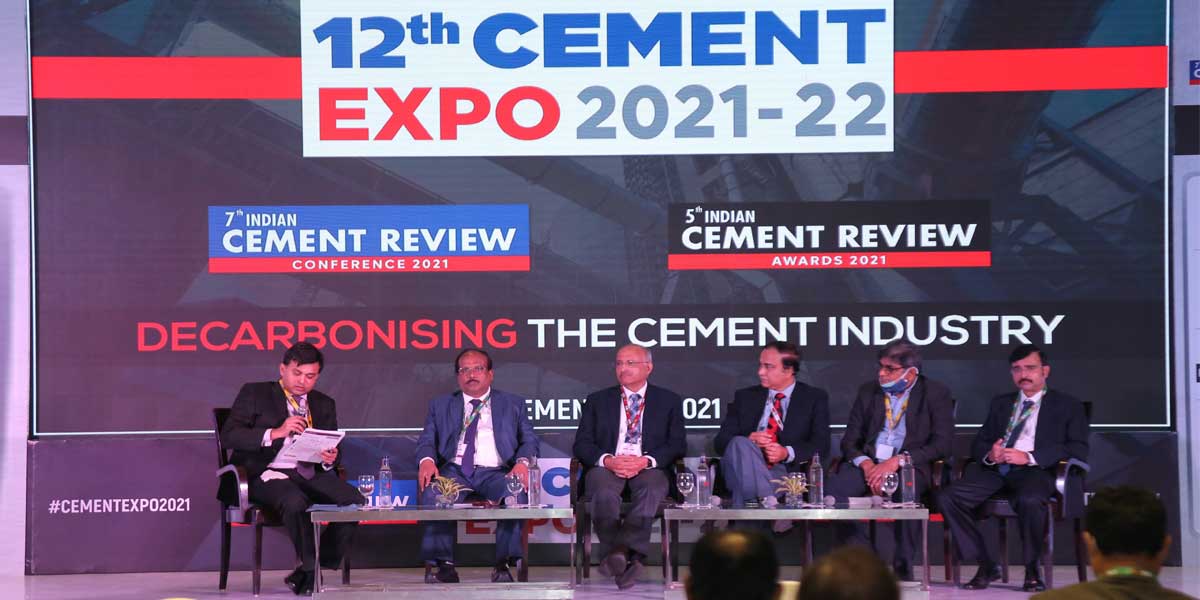Action-driven panel discussions at the event addressed key issues like decarbonisation and star performers in the cement sector were honoured.Part of the 12th Cement Expo, the 7th Indian Cement Review Conference, held at The Lalit in New Delhi on 17 December, brought together strategists, companies such as Dalmia Cement, Birla Corporation, JSW Cement and JK Cement and other experts to deliberate upon the theme ‘Decarbonising the Cement Industry’.The inaugural address by Pratap Padode, Founder and President, FIRST Construction Council, brought to light alarming statistics about carbon emissions and underscored the need for decarbonisation to address climate change. This was followed by the keynote address by Satish Pandey, Principal Scientist, Flexible Pavement Div, Central Road Research Institute, Ministry of Science and Technology, Govt. of India., titled ‘Current Best Practices and Plants of Tomorrow - Transform India’, and two panel discussions.Panel Discussion 1: ‘Paving the Way Towards Energy and Sustainability’Moderated by Vaibhav Agarwal, Research Analyst and Vice President, Institutional Equity Research, PhillipCapital, panellists for the first discussion included Dr Bibekananda Mohapatra, Director General, National Council for Cement and Building Materials (NCCBM); Shrinath Savoor, Jt President (Strategy and Business Development), Shree Cement; Dr Sujit Ghosh, Executive Director, Dalmia Cement; Madhusudhan R, Country Head, IKN Engineering; and Subhasis Chattopadhyay, Head - Projects, Birla Corporation.Highlights included the use of supplementary raw materials like fly ash and bio fuels like biomass and agricultural waste, importance of technology in carbon capture and the need to upgrade existing cement plants. The panellists also discussed the importance of climate finance and wider acceptance of blended cement, especially in government-backed projects.Discussing Dalmia Cement’s journey towards net zero, Ghosh said, “We developed a vision to be carbon negative by 2040. The top leadership drove the idea and created the buy-in.” For his part, Chattopadhyay said, “Most upcoming projects are based on waste heat power. This helps both in terms of costs and CO2 emissions. The technology required to use alternative fuels is also crucial as new technologies are coming up in pyro-processing and other processes.”When asked whether there is a trade-off between sustainability and profitability, Savoor responded, “Energy conservation in the cement sector started long before the concept of sustainability. Energy is the biggest manufacturing cost and any saving reflects directly on the bottomline. There is no divergence between profit and sustainability.” He added that blended cement is good for both sustainability and the bottomline.“In India, we are blessed to have supplementary materials like slag and fly ash, although there is less acceptance of blended materials,” said Mohapatra. “Today, 67 per cent of the cement produced uses slag generated by the steel plants. We have an excess of 20,020 mt of fly ash. Despite this, there is a lack of acceptance for blended cement in the public sector.” He also pointed out that there are huge deposits of dolomite still to be explored. And addressing how clinker cooler can contribute to decarbonisation, Madhusudhan said, “If the entire Indian production of cement is cooled with energy-efficient cooling, we will save approximately 4.4 mt of fuel.”“It is predicted that cement production in India will go up from 300 to 600 mt,” said Chattopadhyay. “New plants will have new technologies and construction methodologies, which will ensure low consumption of cement and indirectly contribute to decarbonisation. Existing plants need to be upgraded. The question is funding. In India, we are looking at funding at lower interest rates; maybe CO2 emissions can be taken into consideration instead of credit rating. We are also looking for a proper policy framework.”Pointing out that transportation of fly-ash and carting slag are huge tasks, Ghosh laid emphasis on the need for green financing, policy interventions and transport subsidies. Acceptance of blended cements by government projects is another challenge.For his part, Savoor said, “Even if you replace all your fossil fuels with non-fossil fuels, the CO2 in limestone will still add to emissions. You need technologies like carbon capture.” He added that ‘climate finance’ (for retrofitting) for developing countries has to come from developed countries. However, no agreement was reached in COP26 regarding the $ 100 billion promised by the developed countries.Followed by the panel discussion, Ashwini Khunte, Asst. Manager - Conveyor Products, Martin Engineering gave an outstanding presentation on Remote Monitoring of Belt Cleaners.Fireside chatModerated by Sachin Joshi, Sustainability Consultant, and Head, UNIDO FIC-SID, panellists Mahendra Singhi, MD and CEO, Dalmia Cement Bharat, and Rajnish Kapur, COO, JK Cement, discussed key measures to support the economy and reduce environmental pressure as well as innovations and best practices. Both experts highlighted the fact that planetary boundaries are changing. Singhi also pointed out that India is the only country with online monitoring of carbon emissions.In his valedictory speech, Sumit Banerjee, Chairman - Editorial Advisory Board, Indian Cement Review, called climate change “a complex and wicked problem.” He pointed out, “It is important to understand if cement production is sustainable. Carbon sequestration, synthesising cement and use of hydrogen as fuel in a kiln are three possibilities that exist today that can provide some hope in decarbonising cement. But these attempts are not serious because the cement industry’s participation in these endeavours is lukewarm.”Panel Discussion 2: ‘Clean-Energy Future’Moderated by Sanchit Makhija, Principal, AT Kearney, the panellists for the second discussion were Manoj Rustogi, Head - Sustainability, JSW Cement; Jeevaraj Pillai, Joint President (Packaging), Uflex; Saurabh Palsania, Executive Director, Dalmia Cement; SK Rathore, President, JK Cement; and Jeyamurugan Kandasamy, Head of Connected Assets Global, Group Digital - Smart Products, FLSmidth. They deliberated upon clean energy; the role of tech and AI in optimising energy consumption by improving equipment productivity; carbon costs; sustainable cement packaging; and municipal solid waste (MSW) as fuel.The discussion opened on hydrogen as a green fuel and technology advancement to reduce losses incurred during clinkerisation. According to Rathore, “Policy intervention is required to push energy-saving efforts, such as the upcoming carbon tax. Right now, we don’t have the ‘Pollutants to Pay’ policy in India.” Palsania added, “If investment in the waste heat recovery process is subjected to capital subsidy, it will attract a lot of investment. We need one solar power policy for the entire country to overcome stumbling blocks in investment.”Rustogi underscored that, technically, cement manufacturers would not have to rely on the power grid if they can source 60-70 per cent of energy from waste heat recovery and 30-40 per cent from solar power. The panel also pointed out that except for Rajasthan, other states do not recognise waste heat recovery as a renewable energy source.As for MSW, Palsania said, “The cement industry has been using waste since its inception but non-segregation of waste is an issue. Almost 1,855 lakh tonne of MSW is lying across India. We need to improve the equipment and organise the sector better.” One challenge that needs to be resolved is the separation of ash content and chlorides from refuse-derived fuel (RDF).Meanwhile, Makhija explained that sustainable packaging can play a big role in decarbonisation. “India produces 350 mt cement, approximately 8 per cent of which is getting wasted,” he said. “We have developed a shower/moisture-proof bag that prevents lump formation.” He recommended that paper be replaced with laminated woven polypropylene bags.Moving on to carbon taxation, Rustogi said, “Most civil companies in India have internal carbon pricing. In Europe, carbon pricing is quantifiable. This is reflected commercially in the pricing of the cement. The price of green or low-carbon cement goes up and people are ready to pay for it.”As for digitalisation in material and process optimisation, Kandasamy said, “While working with global companies, we found they were hesitant to connect their plants to a Cloud network. Second, there is a huge gap between IT and OT.”Shifting the focus to material efficiency and supplementary cementitious materials (SCM), Rustogi said, “There is a myth that the quality of cement with SCM and blended cement is not as good as OPC. Blended cement has a huge impact on the carbon footprint. For instance, in slag cement, with a clinker ratio of only 30-35%, you are bringing down carbon emission to 30 per cent, from 800 kg to 250 kg per tonne. New materials such as geopolymers in the research stage involve zero clinker use.”The discussion ended with the importance of carbon labelling. “With carbon rating, OPC will be rated high compared to blended cement,” said Rathore. “Such a rating will educate users.” Palsania added that for carbon labelling to be effective, carbon credit and carbon exchange should be associated with it.The 5th Indian Cement Review Awards 2021JK Cement, Ultratech and Shree Cement swept the 5th Indian Cement Review Awards 2021 among the large category (operating revenue over Rs 5,000 crore).On receiving the award for Person of the Year, Mahendra Singhi, Group CEO, Dalmia Cement, asserted, “The Indian cement industry is poised to go from grey to green in the time to come. It is ready to support not only itself but other sectors too. It is time to think afresh, to reshape and repurpose our business. The Indian cement sector is known as the most energy-efficient and sustainable one in the world. Now it is time to move toward a net-zero economy. I am sure that we would be the flagbearers in this effort across the globe.”The evening concluded with cocktails and dinner, and a heartfelt appreciation from the industry stakeholders on the efforts put in by the FIRST Construction Council in recognising and applauding the progress of the Indian cement industry.The event was supported by Platinum Partner – JK Cement; Gold Partner – Philip Capital, RDC Concrete; Silver Partner – FLSmidth, Shree Cement;Associate Partner – IKN Engineering, Uflex India, Testo India, Mangalam Cement; Presentation Partner - Martin Engineering Association Partner – Indian Society of Structural Engineers, National Highways Builders Federation.The winners!Fastest Growing Cement Company (Large Category over Rs 5,000 crore)JK CementUltraTech CementsShree CementFastest Growing Cement Company (Medium Category between Rs 2,000 crore and Rs 5,000 crore)JK Lakshmi CementBirla CorporationHeidelberg Cement India LimitedOrient CementLargest & Most Profitable Cement Company in IndiaUltraTech CementsFastest Growing Cement Company (Small Category less than Rs 2,000 crore)NCL IndustriesSagar CementsAnjani PortlandLifetime AchievementSuresh Deolalkar, ConsultantPerson of the YearMahendra Singhi, Group CEO, Dalmia CementInnovation of the YearMartin EngineeringJURY MEMBERSAshok Dembla, Managing Director, KHD Humboldt WedagAshwani Pahuja, Chief Sustainability Officer & Executive Director, Dalmia Cement (Bharat)Dr Bibekananda Mohapatra, Director General, National Council for Cement and Building MaterialsDr JD Bapat, Advisor and Development ProfessionalNitin Vyas, CEO, BEUMER GroupMadhav Vemuri, Director and Entrepreneur, Aideas EngineeringRahul Deshmukh, Managing Director, Aluminium, Fives India Engineering & Projects Pvt LtdPratap Kumar Ghosh, Managing Director, Ercom Engineers Pvt LtdGoverdhandas Daga, Director, Secmec ConsultantsDD Wanjale, Managing Director, Gebr. Pfeiffer (India) Satish Pandey, Principal Scientist, Flexible Pavement Div, Central Road Research Institute, Ministry of Science and Technology, Govt. of India.


















